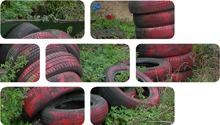
Tyres Plastic 16 01 03
Tyres are made predominantly from rubber with an internal fine wire mesh for integrity. They are produced in various sizes for cars, motorbikes, trucks and plant. They may arise on demolition and refurbishment sites from maintenance of vehicles during projects, but are mostly left on site from previous owners or by fly tipping. Although rare, shredded tyres (crumb) may also be revealed as landscaping from a former use. Tyres and shredded tyres are not hazardous waste.
Usage & Probable Locations
Tyres are commonly used for vehicles. Used tyres or shredded tyres may have been used as landscaping material, playground features, play equipment, plant pots, highways, pavements, drainage fill material, equestrian surfaces, sports and safety surfaces or in tyre bales. Tyre bales may have been used for shoring, bunding, flood defences and landscaping. Tyres are also commonly found on derelict sites as fly-tipped materials.
Personal Protective Equipment
PPE requirements indicated are for guidance purposes only. DRIDS has identified the PPE that is mandatory on all demolition projects and ones that may be required subject to site specific Risk Assessment & Method Statement (RAMS). Hover over the icon to determine the types of PPE required for the removal of this material.
Removal, Segregation & Storage
Whole tyres that are destined for reuse or remoulds should be segregated and stored safely as flat or interlocked bundles to prevent movement. They should also be stored away from plant movements to prevent splash damage. Tyres or shredded tyres destined for recycling or energy recovery need less protection and should be stored in a separate recycling skip. There is little need to store tyres under cover as they are robust against weather. Ensure the company removing tyres is properly licensed to do so - enquire through the Environment Agency Public Register or Tyre Recovery Association.
Fixtures, Fittings & Connections
Health & Safety
Subject to task-specific Risk Assessment & Method Statement (RAMS). Use correct protective equipment. Wear gloves to handle tyres to prevent irritation, cuts and abrasion. Wear eye protection when using hand tools. Only use 360 plant, attachments, front loader or dumper trucks if properly trained. Tyres may contain residues of hazardous materials if they have been fly-tipped.










